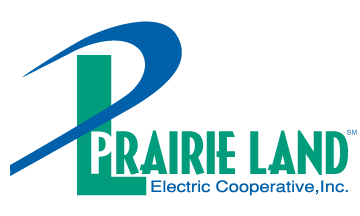This topic was featured in the July 2025 Kansas Country Living Centerspread.
When outdoor temperatures soar, electricity use increases, which creates demand spikes, placing significant strain on the electric grid.
At Prairie Land Electric Cooperative, we work closely with our generation and transmission provider, Sunflower Electric Power Corporation (Sunflower), headquartered in Hays, to plan for the resources and infrastructure needed to keep your lights on and your home or business running. While this local partnership is essential, we’re also part of a much broader regional network. The electric grid is an interconnected system that stretches well beyond Prairie Land and Sunflower.
This system includes a diverse mix of energy resources, some of which can vary in output depending on weather and other factors. This variability adds complexity to maintaining a stable power supply, especially during periods of extreme demand.
During summer months, when electricity use spikes nationwide, demand can exceed supply, particularly during prolonged heat waves. In these rare situations, the Southwest Power Pool (SPP), which operates the regional grid across 14 states including Kansas, may issue an Energy Emergency Alert (EEA).
These alerts ask utilities to encourage consumers to reduce electricity use. If conditions worsen, SPP may direct utilities to implement temporary rolling outages to help stabilize the grid and avoid wider disruptions.
Should this happen, we will keep you informed, including posting EEAs on our website and Facebook page.
Here at Prairie Land, we also work proactively with Sunflower to strengthen our part of the grid. Through regular system maintenance and grid modernization efforts, we strive to build resilience. Still, keeping the grid reliable requires a shared effort — especially during extreme heat — and that includes you.
To help keep the power flowing to your home and your neighbors, here are a few simple ways you can reduce strain on the grid:
- SET YOUR THERMOSTAT TO THE HIGHEST COMFORTABLE TEMPERATURE AND RAISE IT WHEN YOU’RE AWAY. The greater the difference between indoor and outdoor temperatures, the harder your cooling system works.
- PRO TIP: Seal air leaks around windows and doors with caulk or weatherstripping to keep cool air inside.
- AVOID RUNNING TOO MANY MAJOR APPLIANCES AT THE SAME TIME. Stagger use of dishwashers, ovens and dryers throughout the day to ease peak demand.
- PRO TIP: Try starting the dishwasher before bedtime.
- USE CEILING FANS TO BOOST COMFORT. They help you feel cooler without lowering the thermostat.
- PRO TIP: In summer, set fan blades to rotate counterclockwise to push cool air downward.
- BLOCK HEAT FROM THE SUN. Close blinds, curtains, or shades during the hottest hours.
- PRO TIP: Blackout curtains with thermal backing or reflective lining are especially effective.
- COOK SMART. Smaller appliances like slow cookers, toaster ovens and air fryers generate less heat and use less electricity than a full-size oven.
- PRO TIP: Air fryers use about half the electricity of conventional ovens and cook food faster.
Understanding how extreme heat and today’s evolving energy mix impact the grid is key to keeping our system strong and reliable. By using energy wisely, you not only help reduce stress on the grid but also lower your own electric bills and support the reliability of power in our community all summer long.
